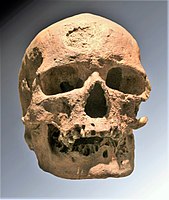克罗马侬人



克罗马侬人(英语:Cro-Magnon,又译克洛曼侬人或克鲁麦农人)是智人(Homo sapiens,其中包括所有现代人类)中的一支,生存于旧石器时代晚期(2~3万年前)。原来是指发现于法国西南部克罗马侬(法语:Crô-Magnon)石窟里的一系列化石,现在则是指第一批在欧洲定居的早期智慧人[1]。
1868年3月,地质学家路易·拉尔泰在法国多尔多涅省莱塞济的克罗马侬石窟里发现了5具骨骼遗骸。其中的模式标本是一颗颅骨,被命名为“克罗马侬1号”。这些骨骼与现代人类拥有相同特征,包括较高的前额、直挺的姿态,以及纤细的骨架。之后在欧洲其他地区以及中东,也发现了相同特征的标本。根据遗传学的研究,克罗马侬人可能源自非洲东部,经过了南亚、中亚、中东甚至北非来到了欧洲[2]。
克罗马侬人在法国、西班牙等国留下大量史前岩画,表示他们具有一定的艺术水准。
有欧洲人类学家认为,现在的巴斯克人是克罗马侬人的直接后裔。
参见[编辑]
参考文献[编辑]
| 维基共享资源中相关的多媒体资源:克罗马侬人(分类) |
- ^ First wave exemplified by: Zlatý kůň woman, Bacho Kiro, Ust’-Ishim man, Oase 1
in Prüfer, Kay; Posth, Cosimo. A genome sequence from a modern human skull over 45,000 years old from Zlatý kůň in Czechia. Nature Ecology & Evolution. June 2021, 5 (6): 820–825. ISSN 2397-334X. PMC 8175239 . PMID 33828249. doi:10.1038/s41559-021-01443-x (英语).
. PMID 33828249. doi:10.1038/s41559-021-01443-x (英语). A female individual from Zlatý kůň, Czechia. We found that she belonged to a population that appears to have contributed genetically neither to later Europeans nor to Asians. (...) A complete genome has been produced from the ~45,000-year-old remains of Ust’-Ishim, a Siberian individual who showed no genetic continuity to later Eurasians. This contrasts with the ~40,000-year-old East Asian individual from Tianyuan whose genome is more closely related to many present-day Asians and Native Americans than to Europeans. From Europe, only the partial genome of an individual called Oase 1 and dated to ~40 ka has been recovered, and this showed no evidence of shared ancestry with later Europeans
- ^ Single, Rapid Coastal Settlement of Asia Revealed by Analysis of Complete Mitochondrial Genomes. Bradshaw Foundation. [2019-01-13]. (原始内容存档于2019-07-28).
| |||||||||||||||||||||||||||||||||||||||||||||||||||||||||||||||||||||||||||||||||||||||||||||||||||||||||||||||||||||||||||||||||||
| 这是一篇与生物学相关的小作品。你可以通过编辑或修订扩充其内容。 |


